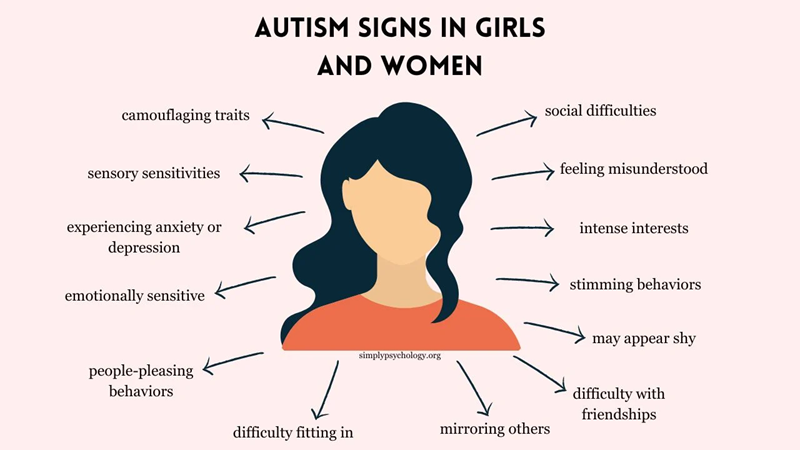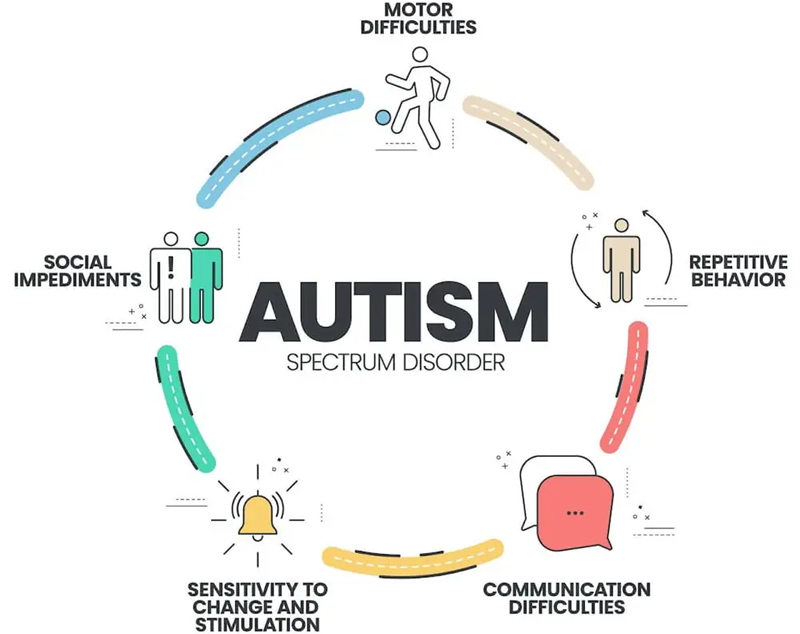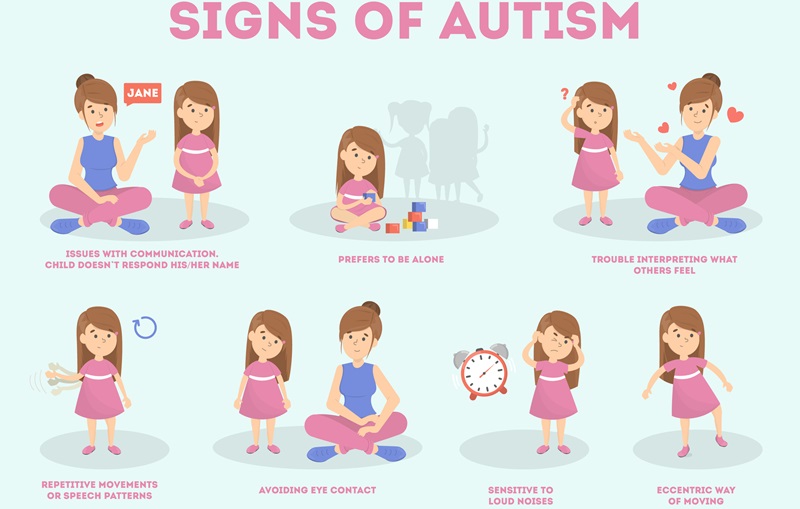Autism Spectrum Disorder (ASD) often presents differently in women than it does in men, making it somewhat more challenging to identify. Women with autism may display a range of subtle signs that can often be overlooked. One of the primary indicators is difficulty in social interactions.
Women with autism may struggle with understanding social cues, engaging in conversations, and maintaining relationships. They might also have an intense interest in specific topics and can be overly focused or obsessive about them. Additionally, they may display repetitive behaviors or have very set routines that they are uncomfortable deviating from.
Sensory sensitivities are another common sign, where they may find certain sounds, smells, textures, tastes, or lights overwhelming. Women with autism may also exhibit emotional challenges and struggle with managing their emotions, often leading to anxiety, depression, or other mental health issues. There might also be a history of being misunderstood or misdiagnosed due to their ability to mask or camouflage their symptoms, a coping mechanism commonly seen in women with autism.
It’s also worth noting that these symptoms can vary in intensity and presentation from person to person. Early diagnosis and intervention are crucial, as they can help provide the necessary support and resources for women with autism to lead fulfilling lives.

Unconventional Social Interactions and Communication Styles
Unconventional social interactions and communication styles often defy traditional norms, providing a refreshing perspective on human relationships. These approaches can include anything from non-verbal communication to innovative digital interactions, offering a broad spectrum of interaction possibilities.
For instance, introverted individuals may prefer written or digital communication over face-to-face interactions, employing their unique communication style to express their thoughts and feelings. Similarly, artistic individuals may communicate through their art, using paintings, music, or dance as a medium to convey their innermost thoughts and emotions.
In the digital age, unconventional social interactions have gained significant traction. Online communities, social media platforms, and video conferencing tools have revolutionized the way people communicate and foster relationships. Introverted or socially anxious individuals often find solace in these platforms as it allows them to interact without the pressure of physical presence.
There is also a growing acceptance of these unconventional social interactions and communication styles as society becomes more diverse and inclusive. People are encouraged to embrace their unique communication styles, promoting authenticity and individuality. However, it is crucial to remember that while unconventional, these styles should still adhere to the principles of respect, understanding, and empathy to ensure a healthy and positive exchange.
Moreover, unconventional social interactions and communication styles can promote better understanding among different cultures, age groups, and backgrounds. For instance, a teenager using emojis to express feelings may seem obscure to an older generation, but it is a common communication style among the youth. Understanding these differences can foster better relationships and encourage open-mindedness.
In conclusion, unconventional social interactions and communication styles are not just non-traditional ways of expressing oneself. They are reflections of our evolving society, inclusive of diverse personalities, cultures, and technological advancements. They represent our acceptance and celebration of individuality, encouraging everyone to communicate in the way that best suits them.
Sensory Sensitivities and Unique Preferences
Sensory sensitivities and unique preferences are interconnected aspects of an individual’s perception and interaction with their environment. Sensory sensitivities refer to a heightened or diminished response to certain sensory stimuli such as light, sound, taste, touch, or smell. These sensitivities can manifest in various ways, ranging from discomfort or distress due to certain textures or sounds, to an intense fascination or comfort derived from specific sensory inputs.
On the other hand, unique preferences are personal inclinations or tendencies towards certain experiences or stimuli. They are shaped by a myriad of factors including, but not limited to, individual temperament, cultural influences, personal history, and indeed, sensory sensitivities. For instance, an individual with a heightened sensitivity to sound might develop a preference for quiet, serene environments. Understanding sensory sensitivities and unique preferences is crucial as they can significantly impact an individual’s learning, social interactions, and overall well-being.
By acknowledging and accommodating these sensitivities and preferences, we can foster more inclusive and supportive environments. Teachers, for example, can modify classroom settings to accommodate students with sensory sensitivities, while employers can adjust workspace designs to cater to the unique preferences of their employees. In a broader social context, acknowledging sensory sensitivities and unique preferences helps promote empathy and understanding, fostering greater respect for diversity and individual differences.

Challenges with Social Norms and Expectations
Navigating through the labyrinth of social norms and expectations can be a complex task, fraught with challenges. These norms and expectations, crafted by society over time, serve as invisible rules that govern our behavior and interactions with one another. However, they often place burdensome, sometimes unrealistic, demands on individuals.
For instance, in various cultures, there are gender-specific expectations, such as men being portrayed as the breadwinners, and women being expected to assume nurturing roles. This binary perspective can limit the extent to which individuals can express their true selves, leading to personal distress. Furthermore, these social norms and expectations can create a fear of ostracization, forcing individuals to conform to patterns they may not fully agree with.
Another challenge arises when social norms and expectations are misconstrued or misapplied, leading to stereotypes and bias. For instance, certain cultures may expect their youth to respect their elders. This can sometimes be misconstrued to mean that the opinions of the young are less valuable, leading to ageism. Similarly, the expectation of politeness can, in certain situations, lead to inauthenticity or even enable unhealthy relationships.
Moreover, the advent of social media has amplified the pressures of social norms and expectations, as individuals are constantly exposed to idealized lifestyles, sparking a culture of comparison and competition. This has led to increased levels of anxiety, depression, and low self-esteem among users.
However, while these norms and expectations can pose significant challenges, they also provide a structure and a sense of predictability in social interactions. They form the bedrock of societal values, guiding individuals on acceptable behavioral patterns. Therefore, while it is crucial to acknowledge the pressures these norms can impose, it is equally important to appreciate their role in shaping cohesive societies. A balanced approach, where individuality is respected and valued alongside social norms, can help alleviate the challenges associated with these expectations.
Special Interests and Intense Focus
When discussing the concept of special interests and intense focus, it is crucial to understand the depth and breadth of these notions. Special interests refer to subjects or areas that an individual is incredibly passionate about and tends to devote a significant amount of time, energy, and thought to. This passion is often so intense that it can seem almost obsessive to those who do not share the same interest.
On the other hand, intense focus refers to an individual’s capacity to concentrate on a particular task or subject matter for extended periods. This level of concentration often surpasses what is typically expected and may even exclude all other activities or considerations. Interestingly, special interests and intense focus often go hand in hand. For example, individuals with certain neurodivergences, such as autism, frequently exhibit both of these traits, as they may have one or more special interests that they can focus on intensely.
Such a combination can lead to exceptional expertise and knowledge in the chosen field of interest. However, it is important to strike a balance, as excessive focus on a single topic can sometimes limit one’s exposure to other vital areas. Therefore, while special interests and intense focus can result in remarkable depth of knowledge and proficiency, it’s equally important to diversify one’s interests and to allocate time for other necessary aspects of life.

Difficulty with Change and Adaptability
Change and adaptability can often present significant challenges to both individuals and organizations. The complexity of adapting to new circumstances, situations, or environments can be daunting, and this difficulty is often exacerbated by innate human tendencies to resist unfamiliar scenarios. The fear of the unknown, coupled with the comfort of routine, can result in a reluctance to embrace change.
This resistance can manifest itself in various ways, such as anxiety, stress, or even outright refusal to acknowledge the need for adjustment. On an organizational level, this resistance can hinder progress, stifle innovation, and create a stagnant atmosphere. On a personal level, difficulty with change and adaptability can limit growth, restrict opportunities, and negatively impact overall well-being.
One common reason for this struggle is the perception of change as a threat. When faced with change, people often feel threatened because they are uncertain about the outcome. This uncertainty can lead to a heightened sense of vulnerability and a lack of control, which can, in turn, fuel resistance. Additionally, the process of adapting to change can be taxing, requiring significant mental, emotional, and sometimes physical resources.
This can make the prospect of change seem overwhelming, further increasing resistance. To overcome these difficulties, it is crucial to foster a mindset of resilience and openness, cultivating skills such as flexibility, patience, and perseverance. By viewing change as an opportunity for growth rather than a threat, individuals and organizations can turn adaptability into a strength rather than a stumbling block.
